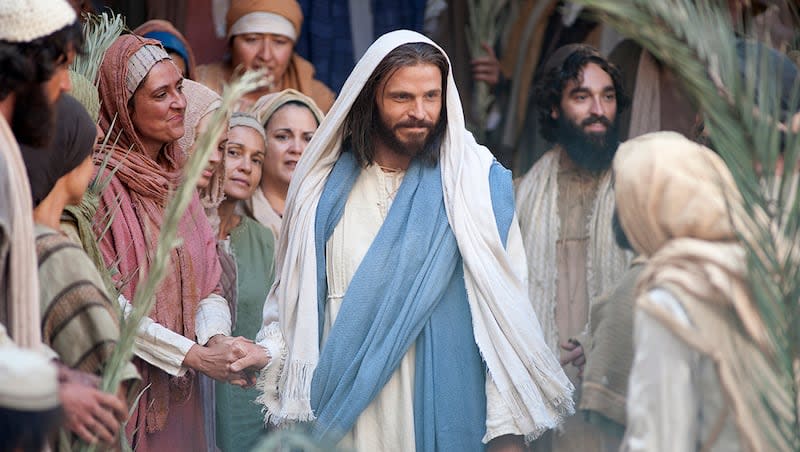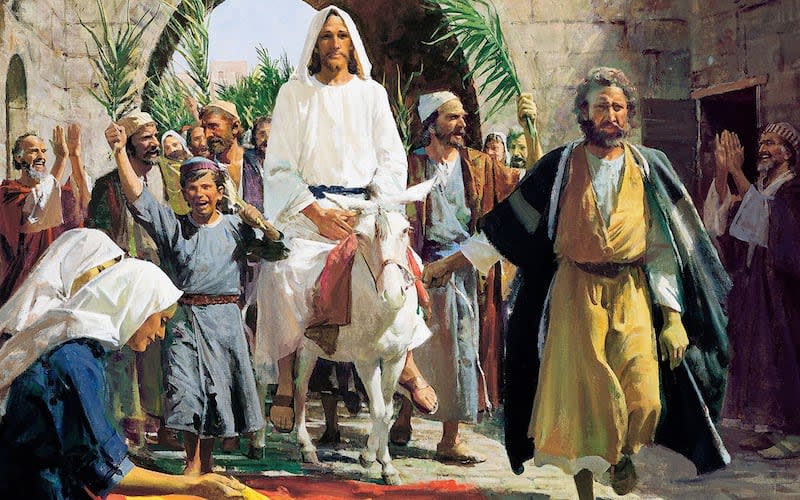How the Church of Jesus Christ’s history with Holy Week has changed in recent years

- Oops!Something went wrong.Please try again later.
This article was first published in the ChurchBeat newsletter. Sign up to receive the newsletter in your inbox each Wednesday night.
The events of Easter have always been revered and honored by Latter-day Saints.
For example, the word “Resurrection” was used 1,321 times in general conferences from the 1850s through the 1890s, even though the word “Easter” wasn’t used at all in conference during that same time period, according to the Corpus of Latter-day Saint Conference Talks.
Easter’s meaning was vital to the practices and theology of The Church of Jesus Christ of Latter-day Saints during the first 70 years, and the events represented by the Christian terms Palm Sunday and Holy Week were regularly described even if the terms were not being used.
Another example is the term Atonement, used in general conferences 281 times in conference talks during those seven decades.
Then in 1904, a general conference speaker first mentioned Easter. Elder Seymour B. Young noted that the important thing is the events of Easter, not agreement among Christian faiths on its date.
“Reference was made yesterday to the life of our Savior, and to the generally accepted idea that yesterday was the anniversary of the day on which he rose from the tomb,” Elder Young said. “However, whether Easter Sunday is the proper day or not, we have no objection to it. The great underlying fact is that he rose from the dead, after having suffered crucifixion for the sins of the world, and that he was the Son of God.”
In fact, Elder Young made a statement that will be a familiar sentiment to many Latter-day Saints today, that the celebration of Easter is not confined to a single day. He said the Latter-day Saints should “not have a Sunday religion like a Sunday coat,” to be set aside when the Sabbath passed.
“When Easter Sunday comes, or when any other Sunday comes, it is the Lord’s day and we reverence his high and holy name. We come together and worship him. Thus to us every Sunday, in a sense, is Easter Sunday, for we worship the Lord on that day, and not only on Sunday, but every day in the week.”
Today, the church observes Easter with a special worship schedule shared only with Christmas — a one-hour Sacrament meeting specially focused on Jesus Christ.
Last year, “Holy Week” was used in a general conference for the first time, according to the corpus, by Elder D. Todd Christofferson of the Quorum of the Twelve Apostles and Elder W. Mark Bassett, a General Authority Seventy. Both noted that Palm Sunday marked the start of Holy Week, using the term in a specific way.
“Today is Palm Sunday, the start of Holy Week, marking the Lord’s triumphal entry into Jerusalem, his suffering in Gethsemane and death on the cross just days later, and his glorious Resurrection on Easter Sunday,” Elder Christofferson said. “Let us resolve never to forget what Christ endured to redeem us. And let us never lose the overwhelming joy we will feel once again on Easter as we contemplate his victory over the grave and the gift of universal resurrection.”
Elder W. Mark Bassett later noted that Palm Sunday is “the beginning of that holy week preceding his great Atonement, which would include his suffering, Crucifixion and Resurrection.”
Just 21 years earlier, in 1992, the unofficial “Encyclopedia of Mormonism,” written by Latter-day Saint scholars, many of them BYU professors, stated that “Latter-day Saints conduct Easter Sunday services but do not follow the religious observances of Ash Wednesday, Lent or Holy Week.”
That remains true of specific observances familiar to Catholics and other Christians, but in general conferences beginning in 2020 and in social media posts this week and on a new webpage, Latter-day Saint leaders now are referring to Palm Sunday and Holy Week.
Palm Sunday was mentioned by two general conference speakers from the 1850s through the 1970s, then five more through 2019.
Ten speakers used the term in conferences in 2020 and 2023.
“The sacred events between Palm Sunday and Easter Sunday are the story of hosanna and hallelujah,” Elder Gerrit W. Gong said in April 2020. “Hosanna is our plea for God to save. Hallelujah expresses our praise to the Lord for the hope of salvation and exaltation. In hosanna and hallelujah we recognize the living Jesus Christ as the heart of Easter and latter-day restoration.”
Easter, Palm Sunday and Holy Week are again being referenced by church leaders this week.
The church released a Holy Week study guide as part of a new webpage called “Jesus Is risen: Celebrating Easter.”
Each day this week and next, a member of the First Presidency and Quorum of the Twelve Apostles is sharing a message about Jesus Christ, concluding on Easter Sunday. The first few messages included more references to Palm Sunday and Holy Week.
As Elder Gong noted in 2020, church President Russell M. Nelson has taught that Jesus Christ “came to pay a debt he didn’t owe because we owed a debt we couldn’t pay.”
He also said that palms are a sacred symbol to express joy for Jesus Christ, and he shared the fact that behind President Nelson’s desk hangs the original painting of Harry Anderson’s “Christ’s Triumphal Entry Into Jerusalem.”

My Recent Stories
First Presidency, apostles releasing daily messages about Jesus Christ to celebrate Easter (March 19)
Want a more Christ-centered Easter? Church releases webpage with ideas, study guide, activities (March 18)
BYU Slavery Project conference seeks reconciliation with examples of slavery in Utah history (March 14)
About the church
President Nelson spoke as the power of covenant-keeping women was celebrated during the Relief Society anniversary worldwide gathering.
Elder Gong encouraged Latter-day Saints to rely on the Spirit when using artificial intelligence.
Elder Quentin L. Cook spoke at the Provo MTC and emphasized the Kirtland Temple, the Book of Mormon and personal testimony in the gathering of Israel.
My colleague Jacob Hess is back with his second installment of a series exploring stories of people who return to faith: Coming back to church after working through history questions.
The two Olympic-bound Latter-day Saint runners testified boldly of faith in an appearance on CNN.
“Jeopardy!” just revealed a category called “The Book of Mormons.” Can you answer these 5 clues?
BYU held an interfaith, academic conference on “The Chosen” Here’s an inside look.
A former BYU soccer player glorified God on social media after her first pro game. See what she said.
There’s a new book about Buffalo Bill’s relationship with early Latter-day Saints. It’s complicated.
What I’m reading
There is a striking new profile of Caitlin Clark as March Madness is set to begin. The piece by Wright Thompson is a master class on reporting and writing and a wonderful, storytelling read about a journey of greatness. It’s must-read. If you’ve been waiting to watch or learn about this superstar basketball player, it’s time to go behind the scenes and really get to know her as she is about to begin playing in the NCAA tournament for the final time. Here’s Thompson on what Clark faces in her life:
“Modern fame is a radioactive thing that corrodes everything it touches and consumes some people completely. Human beings are designed to live in small tribes, where the most important part of everyday life revolves around direct interactions. That vital way of being is undercut again and again by fame. It really messes some people up. Caitlin has been fighting to feel and be and be seen as human since high school, even as she has strived for things that can only be described as superhuman.”

